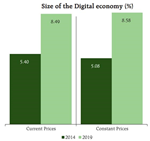

Context
According to the paper published in the bulletin of RBI, India's digital economy grew 2.4 times faster than the economy from 2014-19.

|
Gross value added (GVA) is an economic productivity metric that measures the contribution of a corporate subsidiary, company, or municipality to an economy, producer, sector, or region. |
Key Points:
- Purpose: To measure the size of India’s digital economy and how it interacts with other non-digital sectors.
- Growth in the size of the economy: The size of the digital economy has grown from $107.7 billion in 2014 to $222.5 billion in 2019.
- Growth Rate: India’s digital economy exhibited a growth rate (compounded annually, CAGR) of 15.62 percent between 2014 and 2019.
- In absolute (not in relation to a benchmark) US dollar terms: India’s economy (GVA) grew annually at a compound rate of 6.59 percent.
- Employment: It has been estimated that 62.4 million workers are employed in India's overall digital economy.
- The cumulative effect of the above-given numbers has made India’s digital economy to grow 2.4 times faster than the Indian economy itself.
|
Components of India’s digital economy:
|
What is the digital economy?
- The digital economy is the economic activity that results from billions of everyday online connections among people, businesses, devices, data, and processes.
- The backbone of the digital economy is hyper-connectivity which means the growing interconnectedness of people, organizations, and machines that results from the Internet, mobile technology, and the internet of things (IoT).
Digital economy and its impact on other sectors:
- The core digital economy acts as a supplier of value-added to the non-digital sectors because the forward linkages are stronger than the backward linkages.
- Forward linkage refers to what other products can be built, produced, or made using that particular product.
- Industries with the highest forward linkages from the core digital economy in 2019 are:
- Construction
- renting of machinery and equipment
- food beverages and tobacco
- textiles and textile products, and
- electrical and optical equipment
- Policies such as the Make in India, and PLI scheme, act as a pull force to incentivize domestic production of computers, electronics, etc. in the country. This results in:
- spurring innovation
- generating efficiencies and
- improving services
Advantages of the Digital Economy
- Increased productivity: The digital economy has increased the productivity of businesses as they can now use technology to automate their operations and processes.
- Increased competitiveness: Businesses can use technology to improve their products and services. This has increased the competitiveness of businesses.
- Increased employment opportunities: The digital economy has generated new job opportunities as new businesses are springing up.
- Increased transparency: The digital economy has increased the transparency of businesses as they can now use technology to share information with their customers.
- Innovation: The digitization of businesses and their processes leads to innovation with respect to not just offerings but also the way businesses operate.
Why the non-digital sectors has not grown at a comparable pace?
- This is because the impact of digital innovations on the growth of non-digital sectors in an economy may take longer to reflect in terms of numerical growth.
Way Forward:
- Need for Digital Literacy: Given that, 62.4 million workers are employed in India's digital economy, it underscores the need for digital literacy and skilling.
- More jobs to come: As internet connectivity and industry 4.0 alter production and consumption technologies, high growth of employment is expected in the digital sector in the coming years.


